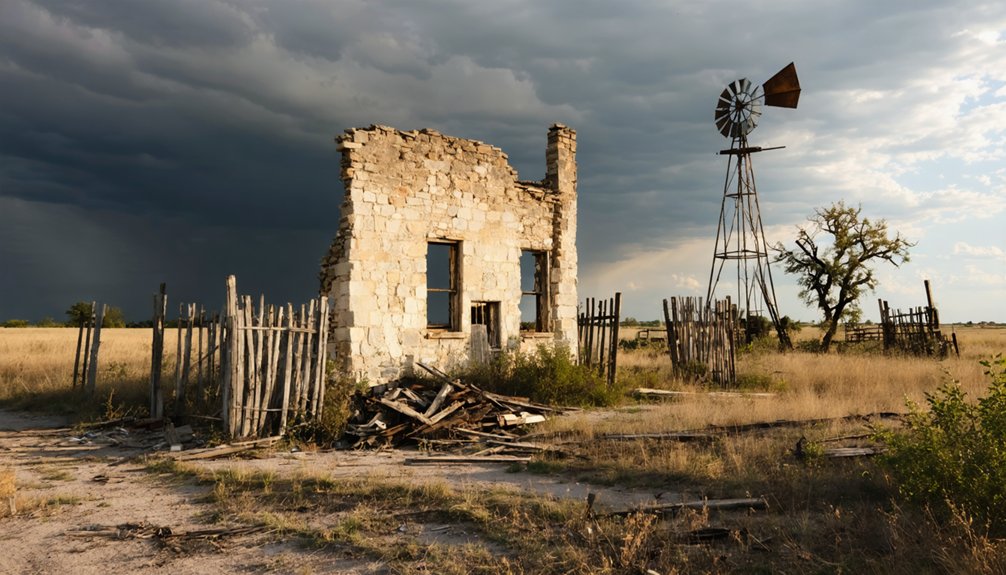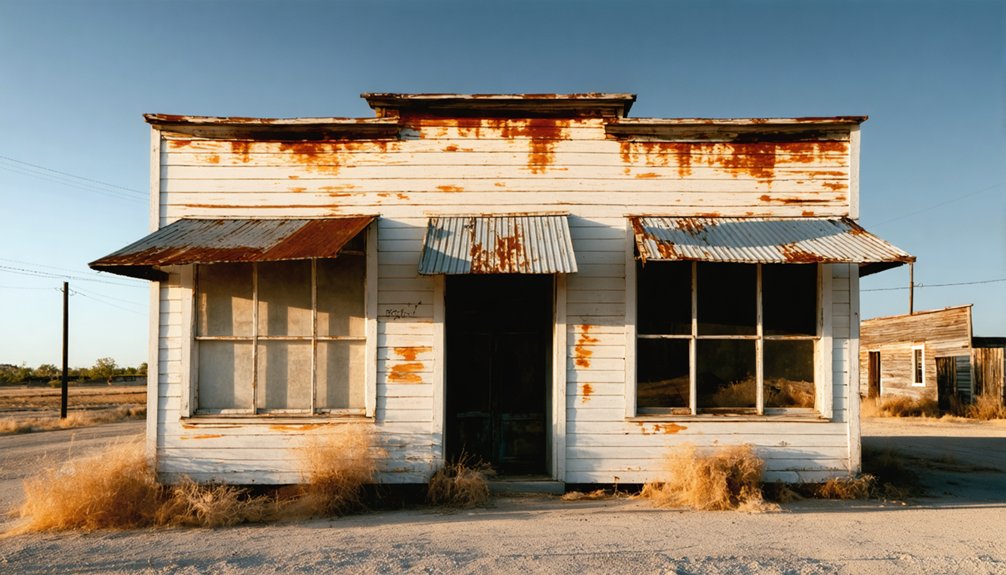You’ll find Mineral Springs in northwestern Panola County, Texas, where African-American settlers established a community in the 1870s around springs believed to have healing powers. The arrival of the Weatherford, Mineral Wells and Northwestern Railway in 1889 brought brief prosperity, but the town’s fortune declined when the waters’ curative properties proved questionable. By 1948, the church had collapsed, and today, only folklore and ghost stories remain of this once-hopeful settlement, whose deeper mysteries still intrigue visitors.
Key Takeaways
- Mineral Springs was established in the 1870s as an African-American settlement centered around a church in Panola County, Texas.
- The town grew around mineral springs believed to have healing properties, attracting health tourists seeking natural cures.
- Railroad development initially boosted the economy but declined after 1936, contributing to the town’s eventual abandonment.
- The African-American church’s collapse in 1948 marked the end of organized community life in Mineral Springs.
- Today, few visible traces remain of the former community, with nature reclaiming most signs of human habitation.
Origins and Early Settlement
While many Texas settlements emerged around transportation routes or agricultural opportunities, Mineral Springs originated due to a natural feature that captured early settlers’ attention – a spring believed to possess healing properties.
You’ll find this ghost town nestled in the piney woods of northwestern Panola County, where early settlement patterns developed around the promising waters.
In the 1870s, African-American settlers established the community’s first significant piece of community infrastructure – a church that became the settlement’s heart. Like other historical sites across Texas, the church helped establish a strong sense of community identity and heritage.
Many health-seeking visitors traveled to similar springs across Texas seeking cures through mineral-rich waters, reflecting a widespread belief in natural healing remedies.
The surrounding area remained largely rural and dispersed, with residents focusing on small-scale farming and lumber activities.
Despite hopes tied to the spring’s medicinal qualities, the settlement maintained a modest footprint, with basic residential structures scattered throughout the densely forested landscape.
The Railway’s Rise and Fall
Although Mineral Springs had established itself as a small rural community, the arrival of the Weatherford, Mineral Wells and Northwestern Railway in 1889 marked a pivotal shift in the region’s development.
With $500,000 in capital investment, the railway expansion quickly transformed local commerce and accessibility. The railway’s early success was evident through its ownership of two locomotives and ninety cars by 1891. Similar to Mineral Springs, the discovery of mineral springs in Sour Lake led to its initial settlement and eventual transformation.
The railway’s impact on economic shifts can be measured in three distinct phases:
- Growth (1891-1908): Passenger and freight services flourished, extending 43 miles from Weatherford to Graford.
- Evolution (1931-1945): Declining passenger revenue but increasing freight earnings led to service changes.
- Decline (1936-1992): Progressive track abandonment culminated in complete closure after the City of Mineral Wells withdrew subsidies.
You can trace the town’s fate through the railway’s story, as its eventual closure contributed to Mineral Springs’ transformation into a ghost town.
Healing Waters and Local Legends
You’ll find the most enchanting stories of Mineral Springs in its Victorian-era health tourism claims, where desperate visitors sought cures for everything from tuberculosis to female reproductive issues in the town’s mineral-rich waters.
The Famous Mineral Water Company capitalized on these beliefs, bottling “Crazy Water” and shipping crystallized minerals nationwide while promoting near-miraculous healing properties. The unusual water was first tested on local livestock before human consumption began. The water came from the Crazy Well and quickly gained popularity among health-seeking tourists.
Despite the widespread testimonials and doctor endorsements of the era, many of the springs’ purported medical benefits remained scientifically unproven, marking a fascinating chapter in American health tourism where hope often outpaced medical reality.
Springs of False Hope
Despite its promising name, Mineral Springs earned a reputation as a place of unfulfilled dreams centered around its natural springs’ supposed healing powers.
The healing myths that drew settlers and travelers seeking cures ultimately led to abandoned hopes, as no scientific evidence ever validated the waters’ medicinal properties. Similar paranormal hopes draw visitors today to the haunted Hill House, where believers seek connections to the supernatural.
- The springs, once central to community identity, now lie forgotten in overgrown woods.
- By 1948, even the African-American church had collapsed, marking the end of organized community life.
- The ghost town’s remaining folklore focuses on stories of desperate health-seekers who never found their miracle cures.
Unlike nearby Mineral Wells, which maintained its tourism through similar claims and even built the fourteen-story Baker Hotel, Mineral Springs faded into obscurity, leaving only tales of false promises.
Victorian Health Tourism Tales
The Victorian era ushered in a golden age of health tourism at Mineral Wells, sparked by James Lynch’s family’s 1870s discovery of peculiarly flavored springs.
You’d have found yourself among thousands seeking Victorian treatments at lavish spas and sanitariums, where “taking the waters” promised relief from arthritis, skin conditions, and fatigue. The Crazy Well, discovered in 1885, became the town’s centerpiece after reportedly healing a local woman. The iconic Crazy Water Hotel opened in 1927, becoming a landmark destination for wellness seekers.
By 1920, the town boasted over 400 wells that attracted visitors from across the South seeking therapeutic mineral waters.
Hydrotherapy beliefs drove wealthy visitors like Clark Gable, Teddy Roosevelt, and J.P. Morgan to flock to the town’s 21 mineral water companies and healing resorts.
You could’ve stayed at the Snyder Sanitarium, opened in 1915, or joined other health seekers camping near the springs. The town thrived until modern medicine’s rise in the 1940s led to its eventual decline.
The Baker Hotel’s Haunted Legacy
You’ll find the Baker Hotel’s most famous supernatural resident is T.B. Baker himself, whose spirit allegedly roams the halls alongside that of a tragic mistress who met her end at the property.
The hotel’s history of deaths during its mineral water treatment days has contributed to numerous documented paranormal encounters, including unexplained footsteps and voices echoing through its abandoned corridors.
Today, the Baker Hotel ranks among Texas’s most investigated paranormal locations, drawing ghost hunters who’ve captured EVP recordings and mysterious photographs within its deteriorating walls.
Famous Ghostly Encounters
Among America’s most haunted destinations, Baker Hotel’s ghostly residents have earned legendary status through decades of documented supernatural encounters.
You’ll encounter three prominent spirits whose spectral interactions have captivated visitors and investigators alike:
- TD Baker haunts his 11th-floor suite, leaving lingering cigar smoke and playfully relocating guests’ personal items.
- The red-haired mistress from the 7th floor, known for her distinctive lavender perfume and flirtatious behavior with male tourists.
- The phantom elevator operator, whose presence manifests through unexplained elevator movements and shadowy appearances.
These ghostly sightings are accompanied by consistent sensory phenomena – from mysterious footsteps to whispered voices in empty corridors.
The hotel’s spirits, while active, maintain a relatively peaceful presence, confined to their preferred areas within this historic landmark.
Historical Hotel Deaths
While ghostly encounters continue to intrigue visitors today, understanding these supernatural phenomena requires examining the Baker Hotel’s dark history of documented deaths.
You’ll find that tragic events unfolded within its walls since opening in 1929, particularly in the spa and mineral bath facilities where ill guests sought cures. Mysterious deaths occurred throughout the hotel’s operation, from the Great Depression through wartime, affecting both guests and staff.
After its 1972 closure, more lives were lost as trespassers and squatters ventured into the deteriorating structure. These documented fatalities, combined with deaths during medical treatments and unexplained incidents, have cemented the Baker Hotel’s reputation as one of Texas’s most haunted locations, drawing paranormal investigators and urban legend enthusiasts.
Paranormal Investigation Hotspot
Since its closure in 1972, the Baker Hotel has emerged as one of Texas’s premier destinations for paranormal investigations, with three primary spirit entities drawing ghost hunters and curious visitors alike.
You’ll encounter documented ghostly sightings and paranormal phenomena throughout the building, but these locations stand out:
- The seventh floor, where Virginia Brown’s spirit roams in period attire, leaving traces of vintage perfume and sounds of clicking heels.
- T.D. Baker’s 11th-floor suite, marked by mysterious cigar smoke and playfully displaced personal items.
- Active doorways where investigators report being pushed or touched by unseen forces.
If you’re seeking evidence of the supernatural, you’ll find cold spots, shadowy figures, and unexplained physical contact – especially near Virginia’s former suite, where broken glass and otherworldly encounters await bold explorers.
African-American Heritage and Community Life
The African-American community in Mineral Springs established essential cultural and social institutions during the late 19th century, anchored by their church founded in the 1870s.
The vibrant African-American community built their foundation around a cherished church, creating lasting social bonds in 1870s Mineral Springs.
You’ll find evidence of their community resilience in the church’s crucial role as a social and meeting center until its collapse in 1948. Despite segregation and limited resources, they maintained a strong cultural identity through education, religious life, and social activities.
African-Americans participated in the local economy through railroad work, agriculture, and service roles, though within a restricted job market. Their children attended segregated schools with fewer teachers and resources until the mid-1950s.
Local social activities included band performances, public events, and celebrations that fostered community bonds, reflecting patterns seen in nearby towns where Masonic lodges and orchestras thrived.
Present-Day Remnants and Historical Impact

Today’s visitors to Mineral Springs will find few traces of the once-vibrant community, as dense woods have reclaimed most of the original settlement.
Environmental reclamation has transformed the landscape, leaving only subtle hints of its past existence. You’ll discover that nature has obscured most signs of human habitation, though archeological discoveries remain possible in the area.
Key features you might encounter include:
- The natural spring that gave the town its name, though it’s now unmarked
- Potential artifacts from early Anadarko settlements and pioneer life
- Scattered remnants of logging operations hidden beneath vegetation
While no formal historical markers exist, the site serves as a reflection of rural Texas history, where countless small communities rose and fell as economic conditions changed.
The ghost town’s legacy lives on primarily through historical records and local folklore.
Frequently Asked Questions
Are There Any Remaining Structures or Ruins Visible at Mineral Springs Today?
Ever wonder what’s left of the past? You won’t find any standing structures or accessible ruins for exploration today. Historical preservation efforts haven’t maintained visible remnants, as nature’s reclaimed this once-bustling spot.
What Was the Peak Population of Mineral Springs During Its Heyday?
You won’t find exact population figures due to limited historical records, but considering its small logging economy and railway flag stop, estimates suggest a modest peak before population decline occurred.
Did Any Famous Historical Figures Visit Mineral Springs for the Healing Waters?
While famous visitors flocked to well-known mineral spas across Texas, you won’t find records of any notable historical figures seeking healing waters in Mineral Springs – it remained a small, local settler stop.
Can Visitors Still Access the Original Mineral Spring That Named the Town?
You can’t access the original spring today, as there’s no documented public access point. The site lies in an overgrown ghost town area, likely on private land without maintained visitor facilities.
Were There Any Significant Native American Settlements Near Mineral Springs Before Colonization?
Archaeological evidence reveals Native tribes like the Jumanos and Comanches made seasonal camps around these life-giving springs. You’ll find their historical artifacts scattered throughout the area, showing centuries of indigenous presence.
References
- https://www.tshaonline.org/handbook/entries/mineral-springs-tx
- https://dallasterrors.com/the-baker-hotel-and-mineral-wells-tx/
- https://kids.kiddle.co/Mineral_Springs
- https://austinghosts.com/mineral-wells-and-the-baker-hotel/
- https://www.atlasobscura.com/videos/all-roads-lead-to-texas-hidden-histories
- https://texashighways.com/culture/history/taking-the-waters-the-fascinating-history-of-texas-mineral-water-resorts/
- https://www.youtube.com/watch?v=FIXx-6h6nmI
- https://www.lampasasedc.com/115/History
- https://www.tshaonline.org/handbook/entries/weatherford-mineral-wells-and-northwestern-railway
- http://txrrhistory.com/towers/155/155.htm



